The Sandy Bridge Review: Intel Core i7-2600K, i5-2500K and Core i3-2100 Tested
by Anand Lal Shimpi on January 3, 2011 12:01 AM ESTGaming Performance
There's simply no better gaming CPU on the market today than Sandy Bridge. The Core i5 2500K and 2600K top the charts regardless of game. If you're building a new gaming box, you'll want a SNB in it.
Our Fallout 3 test is a quick FRAPS runthrough near the beginning of the game. We're running with a GeForce GTX 280 at 1680 x 1050 and medium quality defaults. There's no AA/AF enabled.
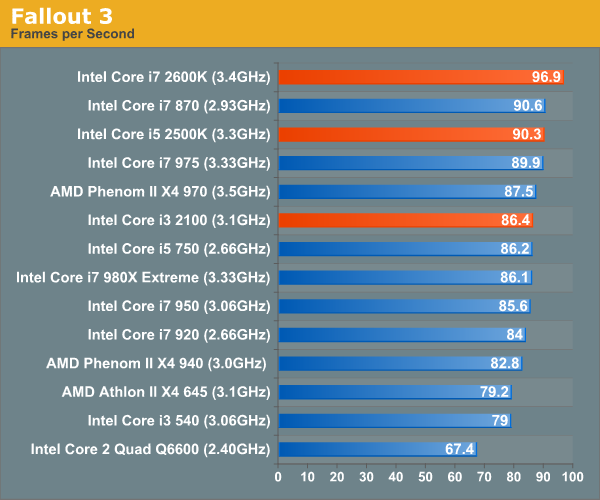
In testing Left 4 Dead we use a custom recorded timedemo. We run on a GeForce GTX 280 at 1680 x 1050 with all quality options set to high. No AA/AF enabled.

Far Cry 2 ships with several built in benchmarks. For this test we use the Playback (Action) demo at 1680 x 1050 in DX9 mode on a GTX 280. The game is set to medium defaults with performance options set to high.
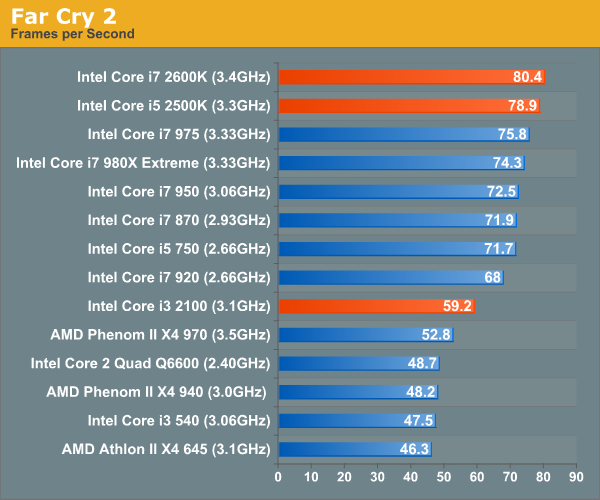
Crysis Warhead also ships with a number of built in benchmarks. Running on a GTX 280 at 1680 x 1050 we run the ambush timedemo with mainstream quality settings. Physics is set to enthusiast however to further stress the CPU.
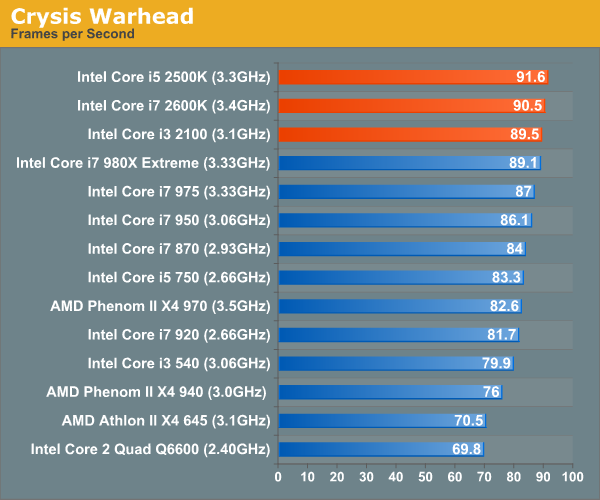
Our Dragon Age: Origins benchmark begins with a shift to the Radeon HD 5870. From this point on these games are run under our Bench refresh testbed under Windows 7 x64. Our benchmark here is the same thing we ran in our integrated graphics tests - a quick FRAPS walkthrough inside a castle. The game is run at 1680 x 1050 at high quality and texture options.
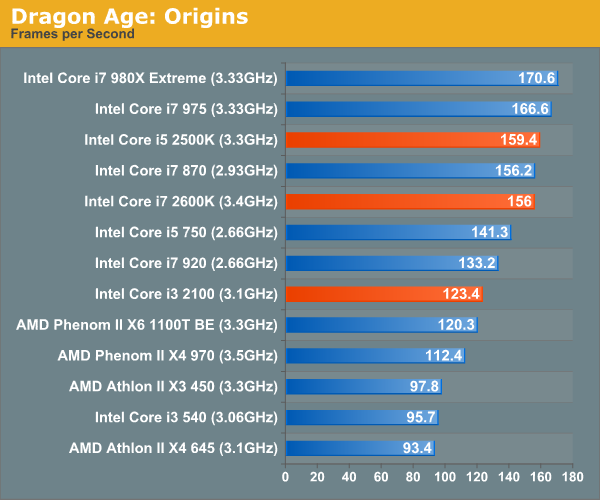
We're running Dawn of War II's internal benchmark at high quality defaults. Our GPU of choice is a Radeon HD 5870 running at 1680 x 1050.
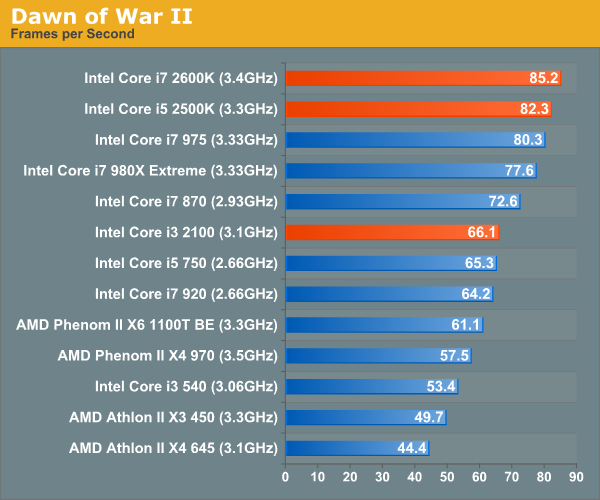
Our World of Warcraft benchmark is a manual FRAPS runthrough of a lightly populated server with no other player controlled characters around. The frame rates here are higher than you'd see in a real world scenario, but the relative comparison between CPUs is accurate.
We run on a Radeon HD 5870 at 1680 x 1050. We're using WoW's high quality defaults but with weather intensity turned down all the way.
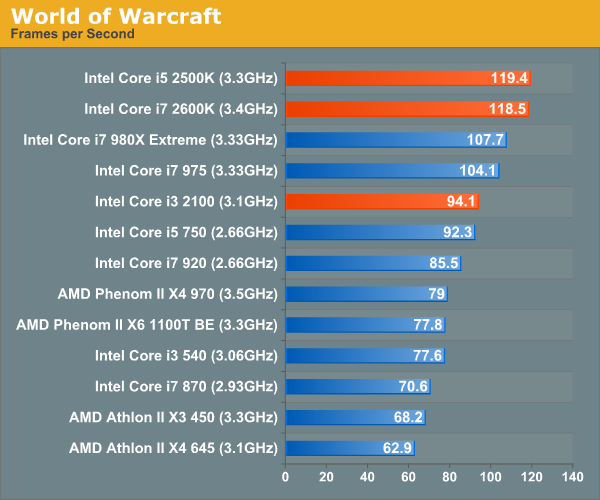
For Starcraft II we're using our heavy CPU test. This is a playback of a 3v3 match where all players gather in the middle of the map for one large, unit-heavy battle. While GPU plays a role here, we're mostly CPU bound. The Radeon HD 5870 is running at 1024 x 768 at medium quality settings to make this an even more pure CPU benchmark.
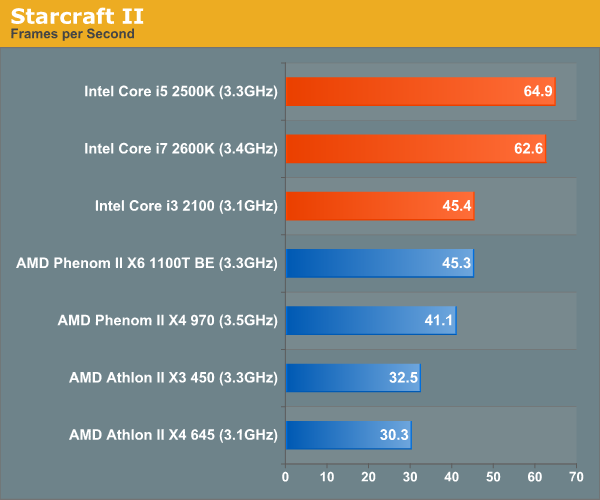
This is Civ V's built in Late GameView benchmark, the newest addition to our gaming test suite. The benchmark outputs three scores: a full render score, a no-shadow render score and a no-render score. We present the first and the last, acting as a GPU and CPU benchmark respectively.
We're running at 1680 x 1050 with all quality settings set to high. For this test we're using a brand new testbed with 8GB of memory and a GeForce GTX 580.
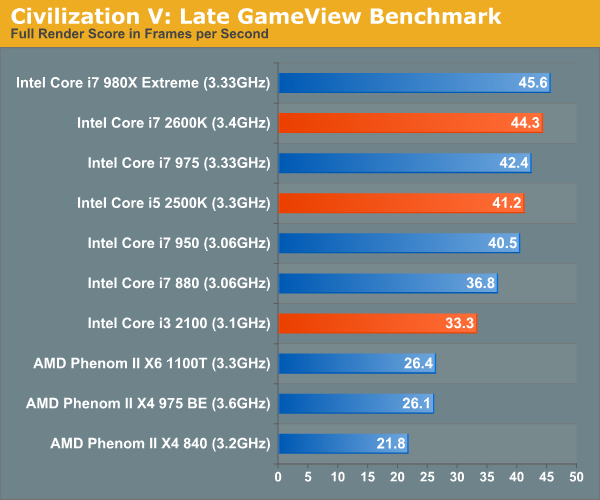
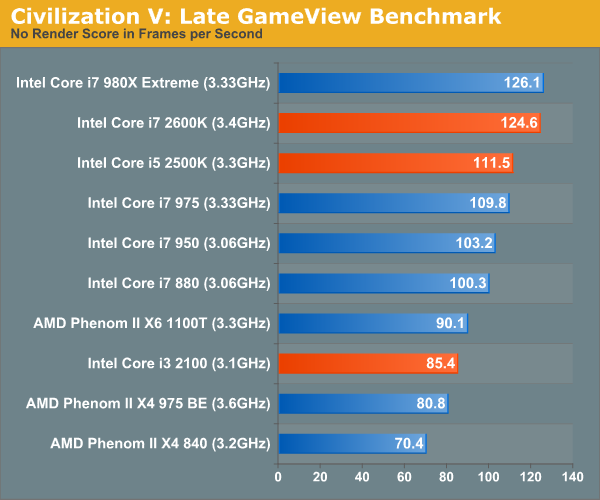










283 Comments
View All Comments
krazyderek - Monday, January 3, 2011 - link
putting the 3000 on the the 2600k and 2500k parts ALMOST made sense as an up-sell, but you can't even use their IGP when on a P series board when you're overclocking! If the Z series wont' be out for a while why the hell would i buy an overclocking chip now? so i can spend more money to replace my H series motherboard with a Z series? Nice try.It's frustrating that you have to pick your sacrifice.... you either get the 3000 with the K sku, or you get VT-d and TXT with the standard sku. Intel doesn't have an offering with both which is kind of ridiculous for high end chips.
mino - Wednesday, January 5, 2011 - link
Yeah, what is most disappointing is lack of Virtualization support even from i3's (!)For christ's sake, Virtualization is the most BASIC requirement for any box today and even s775 Pentium, not to mention the WHOLE AMD lineup have it!
For me this means nothing sub-i5 is useable in ANY capacity, business or private while i5 are (financially) and overkill for most uses.
Well done Intel. You have just lost ~100 $100 certain sales this year. Whatever, will have to wait for Llano for the mainstream stuff.
DrSlothy - Wednesday, January 12, 2011 - link
I think that's an error in the review table, though one I've seen in every Core review so far - did Intel marketing give out wrong specs?Intel website shows the entire Sandy Bridge line-up to have Hardware Virtualisation (VT-x) support, though some are missing VT-d
tech6 - Monday, January 3, 2011 - link
Another great review from Anandtech - thanks guys.It seems odd that the 3000 series graphics engine would be only included on a part designed for over clocking and the boards that support overclocking can't handle integrated graphics. I would have thought that the other way around would have made more sense.
In any case the 2600K and 2500K look like great value parts and are just what I was waiting for!
DanNeely - Monday, January 3, 2011 - link
Does anyone know if QuickSync will appear on LGA-2011 chips? I know they aren't going to have the general purpose GPU components, but this is enough of a performance booster that I'd think Intel would want to keep it on their high end consumer platform in some fashion.ThaHeretic - Monday, January 3, 2011 - link
I see TXT in the last chart above with no explanation as to what it is or why it is differentiated. They -took out- functionality from the unlocked parts? That seems backwards...Kevin G - Monday, January 3, 2011 - link
This functionality will likely appear in Sandybridge Xeons for socket 1155. Intel *generally* segments the Xeons by core count and clock speed, not by feature set like they do for consumer chips. The other feature Intel is holding back is ECC which should be standard in socket 1155 Xeons.DanNeely - Monday, January 3, 2011 - link
It's a hardware security feature. It's best known for the Trusted Platform Module; an on board cryptographic device used in some corporate computers but not used in consumer systems. Probably they just want to keep people from building high end secure servers with cheap, overclocked K parts instead of the much more profitable XEONs for 2-3x as much.http://en.wikipedia.org/wiki/Trusted_Execution_Tec...
kache - Monday, January 3, 2011 - link
I think I'll wait for the SB xeons and the new EVGA SR-2, hoping that EVGA will release it.adrien - Monday, January 3, 2011 - link
Numbers will probably speak by themselves. ;-)17:37 ~ % md5sum *.png
bee3c83b3ef49504e0608a601a03bfc2 6870.png
bee3c83b3ef49504e0608a601a03bfc2 snb.png
So the 6870 and cpu-rendering have the same image.